#dandy aestheticism
Text
all dandy aesthetes are immediately sortable into either 'messy bitch who lives for drama' or 'messy bitch responsible for the drama'
#you know the culprits#oscar wilde#lord byron#dorian gray#anthony blanche#ambrose silk#lord henry wotton#lord risley#the secret history#henry winter#bosie douglas#stephen tennant#miles maitland#dandy#aesthete#dandy aesthete#dandy aestheticism#aestheticism#dark academia
110 notes
·
View notes
Text
NEED TO SAY THAT-
idk if it’s just me but Oscar Wilde is such an inspiration. I often image myself talking to him bout beauty, life, poetry and champagne or reading his own sonnets to the moon
he helped me A LOT I wanna thank him so much
so guys let’s recreate the aesthetic movement
all of u can join <3
we want Oscar back
#oscarwilde#wilde#poetry#wilde1997#aestheticism#beauty#englishliterature#robertross#alfreddouglas#dandy#inspiration#sunflower#literature#writing#poems#victorian#william shakespeare#oscar wilde#aesthetic movement#champagne#life#books#aesthetic#virginia woolf#lovecraft#edgar allan poe#art
56 notes
·
View notes
Text
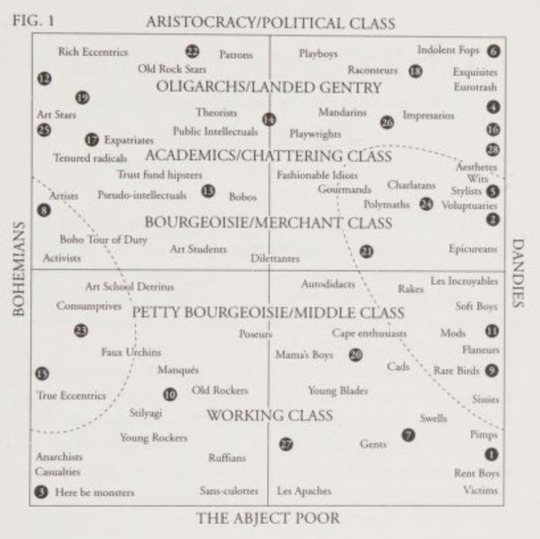
the dandy-fop-bohemian political compass. where are you situated?
2 notes
·
View notes
Text
Distressing like a Dandy
This is just a short little comment on a topic i've been researching lately! as part of my undergrad dissertation ive been looking into dandyism, however I just want to set as a preface that this is not a practise exclusive to homosexual men. It became oftentimes associated with homosexuality towards the late Victorian era with well known dandies like Oscar Wilde and Robert de Montesquiou. This really short discussion will focus more on the prevalence of the movement across both regency and contemporary aesthetics .
The Regency Dandy is oftentimes associated with the practise of a masculine femininity or androgyny, an obsession with vanity that could rival y2k's metrosexuality.
You might think of iconography like this bastardised mimicry of aristocracy, perfect tailoring and an attitude so arrogant he aims to astonish and to stand out. He exists in defiance, an 'aesthetic form of nihilism centring the self as the world', as coined by Jean Baudrillard (Simulacra and Simulation, 1981). This kind of aestheticism caught behind the act of rejection is thought to have fizzled out as the industrial revolution conquered Europe, yet looking- not even closely, looking broadly across western society dandyism as a sociology and artistic aesthetic appears to ebb and flow, constantly circulating through our society.
As we know, the traditional dandy aimed upwards- he was a common man acting in the place of an aristocrat- perhaps better described as acting above an aristocrat, or above society. He wore neatly pressed coats of dark blue, always found himself powdered and perfumed and inserted himself into the circles of the elite yet never becoming one himself. Their defiance of the social norm lead to innovations in fashion in cultivating an appearance that was astonishing yet elegant, daring yet enjoyable- distressed clothing.
Jules Barbey D'Aurevilly's biography of the iconic British dandy George 'Beau' Brummell reveals that its likely that Brummell and his circle often distressed their clothes using a kind of glasspaper- "they had their clothes distressed before they put them on, all over the cloth, to the point where it was no more than a sort of lace- a cloud."
The distress of clothing has always been an integral part of the way in which we experience personal fashions and aestheticism- purposeful wearing on denims in- for example- punk and grunge movements of the 1970s acted in the same way that the distressing of fine fabrics did for the British dandies, only in the opposite direction.
This new dandyism, the act of a defiant vanity, has shifted to push the wearer into commonality instead of aristocracy whilst maintaining that integral obsession with visual appearance and capitalistic tendencies of the ideology. Designer apparel mocks the common man- for example, denims are constructed and designed to allude to the agriculturalists of early twentieth century America with wearing, discolouration, rips, frays and tears etc but are only available to those who have no need to labour. Clothing is purposefully designed to look worn in, think of the controversial 'destroyed' shoes designed by Balenciaga in 2022. The purpose of garments like these is to give the impression of commonality whilst distancing themselves from the experience- they have the ability to give the impression that they are like you whilst maintaining a materialistic capitalistic mindset that allows them to feel above the society they suggest to be living in.
The contemporary dandy is ironic, they are conscious of their clothing, elegantly dressed and massed produced. They act towards the creation of an illusion of individualisation. Where dandies like Brummell sought influence over a handful of people within the aristocratic realm, the modernisation and mass production of the contemporary dandy aims to set precedent over millions.
This illusion of commonality adorned by the pop star, the influencer, the celebrity creates a sense of kinship and relatability for those 'beneath' them (for lack of better term) that allows them to maintain an extremely particular fascination over their vanity and a nihilistic facade of humility that allows them to set trends mimicked by millions. They are their world centre, living and dying before the mirror unable to keep up with the consumer imperative, reinventing themselves constantly to maintain their idolatry.
Of course, the artistic dandy still lives today. The celebrity that rejoices in an androgynous yet fluid vanity neither fully masculine nor feminine. Think Tilda Swinton, Grace Jones. Hell, I'm sure an argument can be made for acts such as Harry Styles and Måneskin as practises of gender neutral fashions and specific vanities become more prevalent once again in celebrity spaces . No, Elton John is not a dandy. He's camp.
8 notes
·
View notes
Text
The Picture of Dorian Gray
TSH has so many references, oblique and obvious, to other works. One I find really interesting are the (oblique) references to Oscar Wilde's The Picture of Dorian Gray.
-> Beauty
Beauty and aestheticism (the theory of beauty and art for their own sake rather than for moral and ideological sakes) are the core theme in both TSH and Dorian Gray. In both stories, the protags 'sell their soul' (Dorian literally, Richard by compromising who he is) for beauty and are destroyed by it. Both protags confuse style for substance and cannot find meaning in something that is not beautiful. Both protags also end up destroying people (Dorian destroys Sybil, Richard himself) for the sake of beauty.
Both novels also end with the protags escaping justice for their crimes. Dorian Gray does get destroyed, but by accident: he decides to make a fresh start and thinks he needs to rip up the portrait to do it, and that kills him. Richard, I guess, is destroyed emotionally?? But the law never catches them.
-> À rebours
À rebours is a novel by Joris-Karl Huysmans. In Dorian Gray, it is the book that corrupts Dorian: "Dorian Gray had been poisoned by a book". It's never mentioned by name, but its all-but-confirmed that its À rebours.
À rebours' protagonist was based on Robert de Montesquiou, a famous 19th century French dandy...which, hilariously, when we meet Francis, is who he is described looking like: "he dressed like Alfred Douglas, or the Comte de Montesquiou".
The other historical figure Francis is described as looking like, Douglas, was famously Oscar Wilde's lover and allegedly the inspiration for Dorian Gray. This is also another reference to Francis' homosexuality. Douglas also famously had a father who did not accept his homosexuality and put Wilde in jail for it.
There is a fantastic post floating around tumblr comparing quotes between TSH and Dorian Gray. I will link it if I find it again.
5 notes
·
View notes
Photo

Thank you! (Here’s my essay on Light in August, by the way.) Absalom, Absalom! is one of those books that demands to be read twice before it can be read once—and I only read it once. My praise will fall short of originality: the sheer sublimity of both the rhetoric and the vision, a single story that is an allegory for all America, a near approach to Faulkner’s wish to have written Moby-Dick. And I love the fin de siècle decadence of it, a mature work that reminds us jejune Faulkner was a dandy strolling with black clothes and a cane, the townfolk mocking him as “the Count.” Along those lines, though I never wrote at length about Absalom, I did post a long passage with brief commentary here on Tumblr nine (!) years ago, back when I read the novel for the first time, and I repost it here. First the quotation and then the almost decade-old comment:
It must have resembled a garden scene by the Irish poet, Wilde: the late afternoon, the dark cedars with the level sun in them, even the light exactly right and the graves, the three pieces of marble (your grandfather had advanced Judith the money to buy the third stone with against the price of the store) looking as though they had been cleaned and polished and arranged by scene shifters who with the passing of twilight would return and strike them and carry them, hollow fragile and without weight, back to the warehouse until they should be needed again; the pageant, the scene, the act, entering upon the stage—the magnolia-faced woman a little plumper now, a woman created of by and for darkness whom the artist Beardsley might have dressed, in a soft flowing gown designed not to infer bereavement or widowhood but to dress some interlude of slumbrous and fatal insatiation, of passionate and and inexorable hunger of the flesh, walking beneath a lace parasol and followed by a bright gigantic negress carrying a silk cushion and leading by the hand the little boy whom Beardsley might not only have dressed but drawn—a thin delicate child with a smooth ivory sexless face who, after his mother handed the negress the parasol and took the cushion and knelt beside the grave and arranged her skirts and wept, never released the negress’ apron but stood blinking quietly who, having been born and lived all his life in a kind of silken prison lighted by perpetual shaded candles, breathing for air the milklike and absolutely physical lambence which his mother’s days and hours emanated, had seen little enough of sunlight before, let alone out-of-doors, trees and grass and earth…
(Placed here, since I can’t find it quoted in full elsewhere on the Internet, for evidence of my pet thesis, indeed my doctoral thesis, that Wilde invented the modernist novel, though to be fair I suppose the allusions here—to Wilde’s great Symbolist drama Salomé with the dirty and anachronistic Beardsley illustrations—are meant to reflect not Faulkner’s mature sensibility but the Decadent [and perhaps somewhat outré for Mississippi in 1909] tastes of this scene’s narrator, Mr. Compson. But note too the resort to the “apolitical” Wilde to describe a scene of implied sexual/racial crossing and [for the reader] confusion [the woman in the Beardsley dress is Charles Bon’s “octoroon mistress” and the boy is her and Bon’s son, raised in a New Orleans brothel but doomed to abject himself in the postbellum South’s racial system and to bear an “idiot” son who will ironically be Sutpen’s final heir], as if Aestheticism is the artistic movement that best captures one of the novel’s central theses–that, as another narrator, Rosa Coldfield puts it, “But let flesh touch with flesh, and watch the fall of all the eggshell shibboleth of caste and color too”—and thus logically leads on to its concluding prophecy of a multiracial empire in the western hemisphere where “I who regard you will also have sprung from the loins of African kings,” per the enthusiastic albeit in the context ironic Canadian Shreve on the novel’s penultimate page. To close on a dry pedantic note, though, I must fault Faulkner for committing one of my pet peeves among common undergraduate writing errors in this otherwise glorious passage: like a kid in freshman comp., our great American novelist confuses imply with infer!)
1 note
·
View note
Text

CALLING ALL MODERN AESTHETES AND DANDIES
( or simply people who would die for beauty )
Thank you for making it this far. Before I proceed, I want to give some context!
I have just entered my last year of high school, and I’m taking an Extension English course which constitutes of a major project that I must send through the the exam centres as part of my coursework.
This is a large, and quite hefty, task. I have chosen to create a moral short-story fiction piece centred on aestheticism, dandyism and the appreciation of beauty.
A part of the project is to present a detailed logbook outlining the research process, audience, purpose and form of the piece that you are presenting.
I thought that, by reaching out to my own community and asking a few questions, I would have a chance to stand out, and get to know my target audience a little better.
If you would like to help me out, then please:
1) When submitting your responses, state your name (it does not have to be your full name if you are uncomfortable with sharing that; a nickname will do just fine) and age.
2) Submit your responses via email to: [email protected]
3) Be as detailed as possible! I’m incredibly interested in all of your answers
4) if you would like to, PLEASE GIVE THIS A REBLOG to spread the word around!
QUESTIONS TO ANSWER:
What does aestheticism mean to you, personally? How does the appreciation and inflation of beauty affect you?
As a 21st century individual, how do you balance aestheticism with the modern world? Do you think that this personal return to values developed in the 19th century is a direct response to a modernised society?
Do you believe that, sometimes, these traditional aesthetic movements may be taken to extremes?
What have been your main inspirations within these communities and movements? For example, to where do you attribute your style, certain interests, mannerisms, etc?
Would you say that the aesthetic and dandy movement is predominantly Western, or has been popularised by Westerners?
Would you personally be interested in seeing a reflection of aestheticism and dandyism in other cultures, religions and non-Western psyches?
What literature attributed to these movements have you enjoyed?
Do you believe there is an inherent disregard for morals within the aesthetic movements, perpetrated by the literature that shaped them (ie; the Picture of Dorian Gray?)
#i'm super excited for this project ahhh#dark academia#aestheticism#aesthete#dandy#dandyism#oscar wilde#xena's year 12 project
97 notes
·
View notes
Photo

Oscar Wilde
Photo by Matthew Bailey
2 notes
·
View notes
Quote
Parolles is an embodiment of that discrepancy between words and deed which plays so important a part in [All's Well That Ends Well] as a whole. The glorious, swash-buckling past upon which he lives, dines out at ordinaries, and attracts rich young patrons like Bertram is nothing but a verbal construct. He is really a parasite and a coward, sheltering behind a facade of language and fine clothes.
Anne Barton in the introduction to All’s Well That Ends Well from the 1974 edition of The Riverside Shakespeare
#and i love him#i just had the thought that if he were a female villainess i would be able to crack the joke ''[paul mccartney voice] and i love her...''#and then i had the immediate subsequent thought that if he were a female villainess. if he were genderbent...#god if only he were genderbent#but. as he is. gay icon#parolles#all's well that ends well#shakespeare#quote#i love the character though it's very wildean#and it feels condescending to compare shakespeare to someone so much after him#but the idea of parolles was quite a proto-dandy... i dig.#given. wilde & his aestheticism probably had his sympathies.#as do i.
1 note
·
View note
Text
ummm dont talk to me unless youve read
Effeminate England: Homosexual Writing After 1885 by Joseph Bristow; Secret Selves: Confession and Same-Sex Desire in Victorian Autobiography by Oliver Buckton; Sacred and Profane in Symbolist at the Art by Luigi Carluccio; Virtuous Vice: Homoeroticism and the Public Sphere by Eric Clarke; Nameless Offences: Homosexual Desire in the Nineteenth Century by H. G. Cocks; Talk on the Wilde Side by Cohen; An Introduction to Logic and Scientific Method by Morris R. Cohen, Ernest Nagel; Sex Scandals: The Private Parts of Victorian Fiction by William Cohen; London and the Culture of Homosexuality, 1885–1914 by Matt Cooke; Family Likeness: Sex, Marriage, and Incest from Jane Austen to Virginia Woolf by Mary Jean Corbett; American Sympathy: Men, Friendship and Literature in the New Nation by Caleb Crain; Emulation: Making Artists for Revolutionary France by Thomas Crow; Love Revealed: Simeon Solomon and the Pre-Raphaelites by Colin Cruise; Queer Beauty: Sexuality and Aesthetics from Wincklemann to Freud and Beyond by Whitney Davis; Friendship's Bonds: Democracy and the Novel in Victorian England by Richard Dellamora; Masculine Desire: The Sexual Politics of Victorian Aestheticism by Richard Dellamora; "Beautiful, Aesthetic, Erotic." The New York Review of Books by Richard Dorment; Romantic Genius: The Pre-History of a Homosexual Role by Andrew Elfenbein; British Aestheticism and Ancient Greece: Hellenism, Reception, Gods in Exile by Stefano Evangelista; The Trials of Oscar Wilde: Deviance, Morality, and Late-Victorian Society by Michael S. Foldy; The History of Sexuality: An Introduction (Volume I) by Michel Foucault; Queer Dickens: Erotics, Families, Masculinities by Holly Furneaux; Idylls of the Marketplace: Oscar Wilde and the Victorian Public by Regenia Gagnier; Selected Poetry by Johann Wolfgang Goethe, David Luke; The Story of Art by E. H. Gombrich; Queer Others in Victorian Gothic: Transgressing Monstrosity by Ardel Haefele-Thomas; Homosexual Desire by Guy Hocquenhem; "Burne-Jones and Gustave Moreau." Horizon: A Review of Literature and Art by Robin Ironside; The Homosexual Revival of Renaissance Style, 1850–1950 by Yvonne Ivory; The Symbolists by Philippe Jullian; Observations on the Feeling of the Beautiful and Sublime by Immanuel Kant, John T. Goldthwait; Sexual Justice: Democratic Citizenship and the Politics of Desire by Morris B Kaplan; Sodom on the Thames: Sex, Love, and Scandal in Wilde Times by Morris B Kaplan; Painted Men in Britain, 1868–1918: Royal Academicians and Masculinities by Jongwoo Jeremy Kim; Between Women: Friendship, Desire, and Marriage in Victorian England by Sharon Marcus; The Other Victorians: A Study of Sexuality and Pornography in Mid-Century Britain by Steven Marcus; Pleasures Taken: Performances of Sexuality and Loss in Victorian Photographs by Carol Mavor; The Last Pre-Raphaelite: Edward Burne-Jones and the Victorian Imagination by Fiona MacCarthy; "The Homosexual Role." Social Problems 16.2 by Mary McIntosh; Victorian Keats: Manliness, Sexuality, and Desire by James Najarian; Walking the Victorian Streets by Deborah Epstein Nord; Catholicism, Sexual Deviance, and Victorian Gothic Culture by Patrick O'Malley; The Place of Enchantment: British Occultism and the Culture of the Modern by Alex Owen; The Renaissance by Walter Pater; Flesh and the Ideal: Winckelmann and the Origins of Art History by Alex Potts; Art for Art Sake's: Aestheticism in Victorian Painting by Elizabeth Prettejohn; Art of the Pre-Raphaelites by Elizabeth Prettejohn; Beauty and Art: 1750–2000 by Elizabeth Prettejohn; Beauty's Body: Femininity and Representation in Victorian Aestheticism by Kathy Alexis Psomiades; Art and Homosexuality: A History of Ideas by Christopher Reed; From Realism to Symbolism: Whistler and His World by Allen Reff, Staley Theodore; Men in Wonderland: The Lost Girlhood of the Victorian Gentleman by Catherine Robson; Edward Carpenter by Sheila Rowbotham; Between Men: English Literature and Male Homosocial Desire by Eve Kosofsky Sedgwick; The Epistemology of the Closet by Eve Kosofsky Sedgwick; Sexual Anarchy: Gender and Culture at the Fin de Siècle by Elaine Showalter; The Wilde Century: Effeminacy, Oscar Wilde, and the Queer Moment by Alan Sinfield; Aubrey Breadsley: Dandy of the Grotesque by Chris Snodgrass; Postal Pleasures: Sex, Scandal, and Victorian Letters by Kate Thomas; Cities of Dreadful Delight: Narratives of Sexual Danger in Late-Victorian London by Judith Walkowitz; "Queer and Then?." Chronicle of Higher Education by Michael Warner
68 notes
·
View notes
Text
Renaissance poet Edmund Spenser, who Paglia sees as Botticelli’s heir and in a comic line with Oscar Wilde’s The Importance of Being Earnest, included in the Bower of Bliss scene in the last canto of the second book of the The Faerie Queene a lesbian scene of girls playing naked in a fountain. The “dark, seductive” decadent lesbian with her “perverse . . . power to captivate her ‘prey,’” Elisa Glick argues, is the counterpart to the aesthete dandy of Oscar Wilde (and Baudelaire and Huysman); she is “a twilight creature who privileges the artificial over the natural, languorously pointing to the exhaustion of beauty in a ruined world.” The scene emphasized beauty, but of a dangerous sterile kind; it was a distraction for the Holy Knight on his quest to defeat evil:
Two naked damzelles he therein espyde,
Which, therein bathing, seemed to contend
And wrestle wantonly, ne car’d to hyde
Their dainty partes from vew of any which them eyd.
Sometimes the one would lift the other quight
Above the waters, and then downe againe
Her plong, as over-maystered by might,
Where both awhile would covered remaine,
And each the other from to rise restraine;
The whiles their snowy limbes, as through a vele,
So through the christall waves appeared plaine:
Then suddenly both would themselves unhele,
And th’ amarous sweet spoiles to greedy eyes revele
Samuel Taylor Coleridge, in the generation before Pater and Wilde, shows the dangerous lesbian vampire in Christabel, which Paglia sees coming from the “decadent perversity,” of Spenser’s “rape infested Faerie Queene” and sees Dorian Gray as its heir:
Beneath the lamp the lady bowed,
And slowly rolled her eyes around;
Then drawing in her breath aloud,
Like one that shuddered, she unbound
The cincture from beneath her breast:
Her silken robe, and inner vest,
Dropt to her feet, and full in view,
Behold! her bosom and half her side—
A sight to dream of, not to tell!
O shield her! shield sweet Christabel!
Yet Geraldine nor speaks nor stirs;
Ah! what a stricken look was hers!
Deep from within she seems half-way
To lift some weight with sick assay,
And eyes the maid and seeks delay;
Then suddenly, as one defied,
Collects herself in scorn and pride,
And lay down by the Maiden’s side!—
And in her arms the maid she took
Coleridge’s “a sight to dream of, not to tell” chimes with Wilde’s characterization of homosexuality (which he got from his male lover’s poem) as “The Love that dare not speak its name.” And both draw on a history of referring to “sodomy” as an unspeakable, unnamable crime that dates back to documents from the sixth century; Hannibal himself, of course, is told that the psychiatry community does not have a name for what he is (3.8) and in Macbeth the witches at their cauldron do “a deed without a name.”
— Geoff Klock, excerpt of Aestheticism, Evil, Homosexuality, and Hannibal: If Oscar Wilde Ate People
#Hannibal#Geoff Klock#excerpt of Aestheticism Evil Homosexuality and Hannibal: If Oscar Wilde Ate People#prose#nonfiction#x#Oscar Wilde#Samuel Taylor Coleridge#The Faerie Queene#Edmund Spenser#Christabel#poetry#homosexuality#lesbian vampire tag#to retag#the other#Elisa Glick#Camille Paglia#Macbeth#Shakespeare
62 notes
·
View notes
Text
'Dandyism, on the other hand, is far closer to a compulsion than it is a philosophy. It is an obsession, more often than not irrational, and occasionally bordering on a psychological disorder. The true dandy cannot behave any other way. Like homosexuality, dandyism is rarely a choice and its practitioners must live by its dictates or be doomed to a life of hypocrisy, unhappiness, and the secret suffering of the underdeveloped and unfulfilled, to say nothing of cargo shorts, Croc shoes and baseball caps. A dandy unable to be a dandy would atrophy and die, which is exactly why one sees dandyism appearing in the most difficult of circumstances, defeating capricious circumstance - it cannot be easily squelched'
Nathaniel Adams, 'Dandies and Aesthetes'
#/lh#dandy aestheticism#dandy aesthete#dandy#aesthete#dandyism#aestheticism#oscar wilde#dandies and aesthetes#dandies
6 notes
·
View notes
Conversation
short summary of the last period
me: wanna drink some champagne rn but I can't afford it
Oscar: *walks in slamming the door* what do u mean
me: I'VE GOT NO MONEY TFFF-
#oscarwilde#wilde#wilde1997#champagne#itshard#needmoneyrightnow#beauty#books#poetry#stephen fry#robertross#writing#poets#literature#imdone#dandy#victorian#aesthetic#aesthetic movement#aestheticism#english literature#art#edgarallanpoe#lily#sunflower#london
8 notes
·
View notes
Text
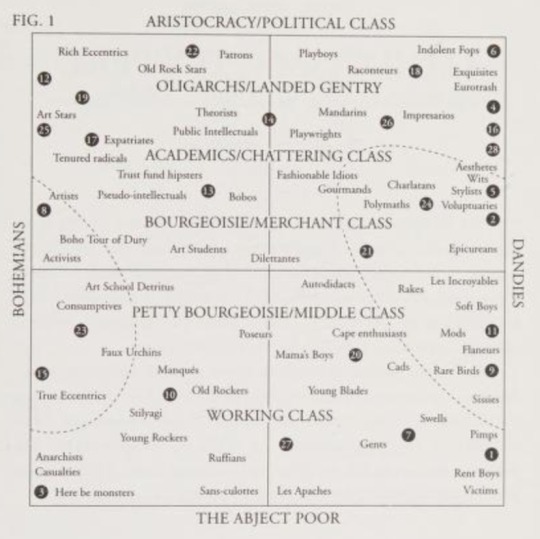
the dandy-fop-bohemian political compass. where are you situated?
2 notes
·
View notes
Photo




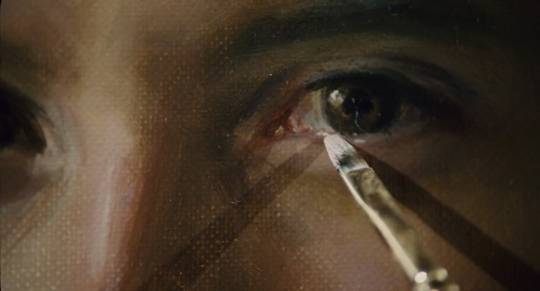
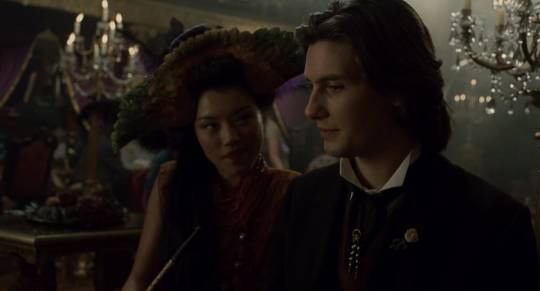
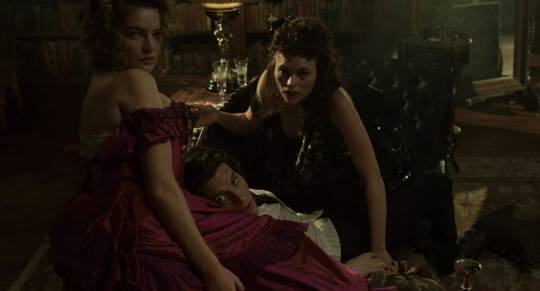
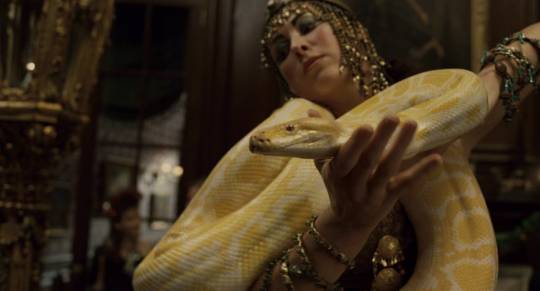
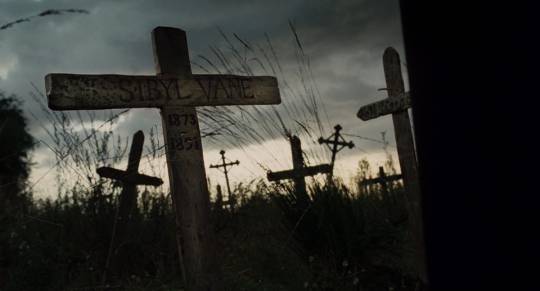

Stills from Dorian Gray (2009), dir. by Oliver Parker
Oscar Wilde's engrossing, wonderfully written depiction of a world in which decadence, hedonism, morbidity, and aestheticism rule features Dorian Gray, the archetypal dandy, the iconic protagonist who makes a Faustian pact in order to preserve his beautiful youthful appearance whilst his figure within the painting ages and degrades as his character slips into degradation and degeneracy through the increasingly sinful, perverted acts he commits. Wilde wants to pierce the depths of life and the human soul and emotions, to test the limits of human experience, encouraging the revelling in the Dionysian aspects of life, indulging in the sensual, focusing on the self, creating a world of excess, spontaneity, and hedonism. He exhibits a disenchantment with Victorian society, its restraints and repression leading to the death of the spirit. Wilde's life is an embodiment of the aesthetic ideal: he was an eccentric, unconventional figure, the dandy, the rebel, the elegant bourgeois artist, promoting art for art's sake and the cult of beauty and pleasure through his ways of dressing, living, and writing. -dianamarin.com
“Those who find ugly meanings in beautiful things are corrupt without being charming. This is a fault. Those who find beautiful meanings in beautiful things are the cultivated. For these there is hope. They are the elect to whom beautiful things mean only Beauty. There is no such thing as a moral or an immoral book. Books are well written, or badly written. That is all. The books that the world calls immoral are books that show the world its own shame.”
“Life is a question of nerves, and fibres, and slowly built-up cells in which thought hides itself and passion has its dreams. You may fancy yourself safe and think yourself strong. But a chance tone of colour in a room or a morning sky, a particular perfume that you had once loved and that brings subtle memories with it, a line from a forgotten poem that you had come across again, a cadence from a piece of music that you had ceased to play... I tell you, that it is on things like these that our lives depend. ”
“Behind every exquisite thing that existed, there was something tragic.”
“Nothing can cure the soul but the senses, just as nothing can cure the senses but the soul.”
“But we never get back our youth… The pulse of joy that beats in us at twenty becomes sluggish. Our limbs fail, our senses rot. We degenerate into hideous puppets, haunted by the memory of the passions of which we were too much afraid, and the exquisite temptations that we had not the courage to yield to.”
“What of Art?
It is a malady.
Love?
An Illusion.
Religion?
The fashionable substitute for Belief.
You are a sceptic.
Never! Scepticism is the beginning of Faith.
What are you?
To define is to limit.” ― Oscar Wilde, The Picture of Dorian Gray
#quotes#picture of dorian gray#the picture of dorian gray#oscar wilde#books#book#literature#victorian
30 notes
·
View notes
Photo


Throughout British history we have seen the rise and fall of many sub-cultures, taking an alternative look onto fashion music and art, these being influences fro many designers. Inspired by the concept of aestheticism looking into freedom and individuality I want to look at different groups that subverted ‘normal’ fashions of the 20th century.
In the 1920s one of the subcultures was Flappers and Dandies. The word Flapper is taken from 1630s English meaning prostitute but by. The 1890s was also used for meaning a teenage girl. From my research, the name Flapper was coined as it referred to birds spreading its wings and learning to fly. Their style consisted of skirts above the knew ( which was shocking for the period) short bobbed hair. Unlike aestheticism it had a did rooted social rebellion and also took into excessive drinking, smoking, driving automobiles and casual sex, which previously had been dismissed and frowned upon. For women, I think this is quite empowering considering a lot of the subcultures I have read into are mainly male-led.
Along with the Flappers, we saw Dandies which were predominately men. Dandyism is much more closely linked to aestheticism, perhaps as they had less to rebel, focusing on elaborate clothing, embracing a more feminism side taking care the way they dress.
After the war, in the 1950s Teddy Boys or more well known as ‘Teds” became popular, inspired by Edwardian Fashion given to young officer that had been removed from the services. The group was made of middle class working young boys, which revolutionary and set the tone of British subcultures to follow. Teddy boys dress followed fashions of baggy suits like the American Zoot suits and coiffed hairstyles.
Developing at the same time were the Mods from the Modernist movement, which was heavily influenced by Italian fashion and music culture. Musicians such as The Who showcase the strong aesthetic. Popular dress from this subculture are Harrington Jackets, parkers and Oxford shirts.
In the 60s′s there was the rise of many alternative cultures, such as skinheads, influenced by ska music and on the opposite end of the spectrum hippies, with completely contrasting styles. Skinheads took inspiration from the Jamaican rude boy, supposedly ‘menacing’ looking, however, this look was adopted by the racist movement of the 70′s, therefore, has a bad connotation. On the other hand, hippies exuded bright colours and bold colours in an ideal to remove them from social construct and spread a message of love and peace. Also during the 1960s, we saw the rise of The beetles one of the most iconic British bands and the use of recreational drugs such as LSD and marijuana. Traits of hippie attire include flamboyant flares, psychedelic prints and coloured shades.
In stark contrast, the 1970s bought around the punk revolution started in the heart of London with designers such as Vivienne Westwood and Malcolm McLaren. These looks had never been seen before, creating something affordable and available to people. It was an incredibly powerful youth movement who used creativity to speak their mind and create an aesthetic that spoke for its self. Punks were very political and had such beliefs as anti-authoritarianism and do-it-yourself. I think the ethos draws parallels with the aesthetic movement however this was much more politically focused. Similar, but not to be confused with is the Gothic Subculture, totally recreating the gothic genre which was around in the 1800s and Victorian Era. Most people see this genre as wearing all black but is more evaluative of a repressed teenage rebellion, wearing dark Neo-victorian styled clothing as a revolt towards the preppy perfect American Dream lifestyle.
Towards the end of the 1900s, we saw subcultures such as New Romantics headed by popular artists such as David Bowie, seeing lots of punks transforming their style with an androgynous and sexual liberated style. Looks made up of heavy makeup on both men and women and almost theatrical outfits form classical and glam rock references.
Looking into these alternative subcultures has given me a better idea of rebellion and non-conformity, which usually has risen from younger generations. I think I would like to pinpoint some of these groups to reference and compare to the movement of the feminist movement of the 1880s. It's interesting to see how when researching most of these groups were mostly male lead, perhaps this is something I could research further.
DANDIES AND FLAPPERS. 2020. What Are Dandies And Flappers. [online] Available at: <https://dandiesandflappers.weebly.com/what-are-dandies-and-flappers.html> [Accessed 12 March 2020].
En.wikipedia.org. 2020. Dandy. [online] Available at: <https://en.wikipedia.org/wiki/Dandy> [Accessed 12 March 2020].
En.wikipedia.org. 2020. Flapper. [online] Available at: <https://en.wikipedia.org/wiki/Flapper> [Accessed 12 March 2020].
En.wikipedia.org. 2020. Mods And Rockers. [online] Available at: <https://en.wikipedia.org/wiki/Mods_and_rockers> [Accessed 12 March 2020].
En.wikipedia.org. 2020. Punk Subculture. [online] Available at: <https://en.wikipedia.org/wiki/Punk_subculture> [Accessed 12 March 2020].
Historic UK. 2020. The 1960S, The Decade That Shook Britain. [online] Available at: <https://www.historic-uk.com/CultureUK/The-1960s-The-Decade-that-Shook-Britain/> [Accessed 12 March 2020].
Huck Magazine. 2020. The Teddy Boys: Britain’S Original Teenage Rebels. [online] Available at: <https://www.huckmag.com/art-and-culture/photography-2/teddy-boys-britains-original-teenage-subculture/> [Accessed 12 March 2020].
the Guardian. 2020. The 10 Best British Youth Cultures. [online] Available at: <https://www.theguardian.com/culture/gallery/2011/jul/10/10-best-british-youth-cultures> [Accessed 12 March 2020].
2 notes
·
View notes